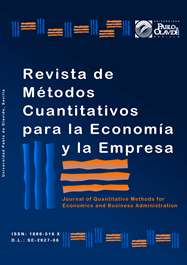From Lifetime Benefits to Temporary Payments: An Approach to Survivors Benefits Reform in Spain
DOI:
https://doi.org/10.46661/revmetodoscuanteconempresa.2556Keywords:
Seguridad Social, pensiones de supervivencia, rentas temporales y vitalicias, equivalencia actuarial, Social Security, survivors benefits, lifetime and temporary income, actuarial equivalenceAbstract
This article explores the possibility of transition from lifetime benefits to temporary payments, specifying the debate in the Spanish Social Security. The theoretical approach is presented and, according to the Continuous Sample of Working Lives, the application of actuarial equivalence and a sensitivity analysis on the main hypothesis, practical results are calculated. As it would be intuitively expected, the transition from lifetime benefits to temporary payments leads to better fairness in the model and a cost reduction in the initial expenses per generation for public protection system, although other perspectives, including reduced expectations for potential beneficiaries, should be also seen. Furthermore, the possibility of using different periods and amounts in the structure of expenses is shown as well. This option improves the protection at the time closest to the fact that generates the benefit.
Downloads
References
Alaminos, E. y Ayuso, M. (2016). Modelo actuarial multiestado para el cálculo de probabilidades de supervivencia y fallecimiento según estado civil: una aplicación al pago de pensiones concurrentes. Anales del Instituto de Actuarios Españoles, 3ª Época, 22, 41-71.
Comisión Europea (2017). Sus derechos de seguridad social. Dirección General de Empleo, Asuntos Sociales e Inclusión. Recuperado el 20 de noviembre de 2017 de http://ec.europa.eu/social/main.jsp?catId=858&langId=es.
Gil Fana, J.A.; Heras Martínez, A. y Vilar Zanón, J.L. (1999). Matemática de los seguros de vida. Majadahonda: Editorial Mapfre.
Devesa Carpio, M.M. (2007). El desequilibrio financiero-actuarial del sistema contributivo de pensiones de la Seguridad Social española. Tesis doctoral. Departamento de Economía Financiera y Actuarial, Universidad de Valencia.
Hernández González, D.; Hernández León, C.F. y Sanabria Borrego, M. (2011). La viudedad del futuro. Estudio y propuestas de reforma global para garantizar su sostenibilidad. Madrid: Secretaría de Estado de Seguridad Social. Recuperado de http://www.seg-social.es/Internet_1/Estadistica/FondodeInvestigacio48073/EstudiosFIPROS/tema2/index.htm.
Hernández González, D. y Devesa Carpio, J.E. (2015). El auxilio por defunción en la Seguridad Social española: pasado, presente y futuro. Revista de Trabajo y Seguridad Social: Comentarios y Casos Prácticos, 388, 95-121.
Hernández González, D. (2015). Caracterización de las prestaciones de muerte y supervivencia de la Seguridad Social española. Reformas estructurales y paramétricas bajo un enfoque económico-actuarial. Tesis Doctoral. Departamento de Economía Financiera y Contabilidad I, Universidad Complutense de Madrid.
Hernández González, D. (2017). Seguridad Social y muerte y supervivencia desde un enfoque no contributivo. Revista de Derecho de la Seguridad Social LABORUM, 11, 117-133.
Moreno Ruiz, R.; Gómez Pérez-Cacho, O. y Trigo Martínez, E. (2005). Matemática de los seguros de vida. Madrid: Editorial Pirámide.
Rodríguez Iniesta, G. (2009). Las prestaciones por muerte y supervivencia: viudedad, orfandad y favor de familiares. Murcia: Ediciones Laborum.
Downloads
Published
How to Cite
Issue
Section
License
Copyright (c) 2018 Journal of Quantitative Methods for Economics and Business Administration

This work is licensed under a Creative Commons Attribution-ShareAlike 4.0 International License.
Submission of manuscripts implies that the work described has not been published before (except in the form of an abstract or as part of thesis), that it is not under consideration for publication elsewhere and that, in case of acceptance, the authors agree to automatic transfer of the copyright to the Journal for its publication and dissemination. Authors retain the authors' right to use and share the article according to a personal or instutional use or scholarly sharing purposes; in addition, they retain patent, trademark and other intellectual property rights (including research data).
All the articles are published in the Journal under the Creative Commons license CC-BY-SA (Attribution-ShareAlike). It is allowed a commercial use of the work (always including the author attribution) and other derivative works, which must be released under the same license as the original work.
Up to Volume 21, this Journal has been licensing the articles under the Creative Commons license CC-BY-SA 3.0 ES. Starting from Volume 22, the Creative Commons license CC-BY-SA 4.0 is used.










